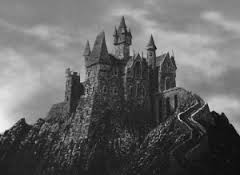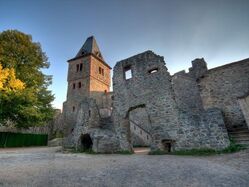Castle Frankenstein is a key element in the Frankenstein myth. In most adaptations, Castle Frankenstein is the gothic dwelling where the mysterious scientist performs his experiments and creates his infamous monster. However, there is no Castle Frankenstein within the text of Mary Shelley’s original novel. Many locations play important roles within the context of the novel, but a mysterious gothic castle is not one of them. In the novel, Dr. Frankenstein’s experiments take place in an apartment rather than in an extravagant castle. And yet, one cannot think of Frankenstein without thinking of the castle. It has become intrinsically tied to the story. So how did this happen? As it turns out, there is an actual Castle Frankenstein in Germany that likely inspired Mary Shelley, though it is doubtful she ever visited. The thirteenth century castle is located in the Odenwald mountain range near the town of Darmstadt, Germany.
Castle Frankenstein in the Frankenstein Myth[]
Despite its absence in the novel, nearly every adaptation of Frankenstein includes a castle where the

mysterious scientist resides. Like many associations of the myth in today’s culture, this can be attributed to the 1931 film starring Boris Karloff. This film was the first time that the Frankenstein story was associated with a castle. Many classic Frankenstein images originated in this film. The traditional image of Frankenstein—square head, stitches, bolts in his neck—comes from this film, as does the notion of referring to the monster himself as Frankenstein. The film also provided the classic image of Castle Frankenstein, atop a hill, surrounded by lightning on the night of the monster’s creation.
From this point on, Castle Frankenstein becomes a staple in film adaptations. In 1974, Gene Wilder starred in a film entitled Young Frankenstein, a parody of the horror genre and the 1930’s Frankenstein films in particular. Mel Brooks’ film is in black and white and uses props modeled after those used in the 1931 film. The film also includes an almost identical shot of Castle Frankenstein.
Even versions of the Frankenstein myth made for children include the spooky castle. In Alvin and the Chipmunks Meet Frankenstein, the singing rodents bump into Dr. Frankenstein and his monster while booking a performance at a theme park. In this particular adaptation, Castle Frankenstein is an attraction that just so happens to house the real monster.
From Boris Karloff to Alvin and the Chipmunks, most images of Castle Frankenstein are remarkable similar. This could be owing to the time period of the Frankenstein story, but could also be a nod to Germany’s real-life Castle Frankenstein.
The Real Place[]
History[]

The real Castle Frankenstein sits atop a hill in Germany not far from the Rhine river. The castle was built before 1250 by Lord Conrad II Reiz of Breuberg, who later called himself Frankenstein. Various branches of his family and their allies lived in the castle for roughly 400 years. In the seventeenth century, the castle acted as barracks for retired soldiers. It was also used as a U.S. army base post WWII. The castle fell to ruins in the 18th century and in the 1850’s it was remodeled by romantic architects who sought to make the castle look more gothic.
Today[]
Today, Castle Frankenstein is a popular tourist attraction. It sits on a mountain range widely used for sports such as hiking and mountain biking and houses a restaurant where tourists can find refreshment. Once a year, the castle is the appropriate sight of an annual Halloween festival. The festival began in 1978 and quickly became one of the biggest Halloween festivals in Europe. The castle also hosts weddings and events such as Horror Dinner Night.
Shelley's Inspiration[]
It is widely believed that Castle Frankenstein served as inspiration for Mary Shelley’s famous novel. Though she likely never visited the castle itself, it is known that she took a boat trip down the Rhine river in 1814, just four years before her novel was published, and would have passed very near it. It is likely that Shelley had at least heard of the castle, and as a Romantic, would have been interested in the ruins. Some academics rumor that Shelley did in fact visit the castle, but kept it a secret to protect her claim to originality.
Mad Scientist[]
One of the most compelling arguments for Shelley having been inspired by the castle is the story of Johann Conrad Dippell. Dippell was born in Frankenstein Castle in 1673. Later in life, he returned to the castle and worked as an alchemist. He created an animal oil which he claimed could cure any malady and has been called his version of the “elixir of life,” a famous pursuit of alchemists. Dippell was obsessed with the human soul and performed experiments attempting to transfer the soul of a dead animal into a living one. Dippell performed many experiments on animals and it is rumored that he eventually turned to experimenting on human corpses.
It is possible that these rumors were spread by competing scientists who were jealous of Dippells success with Prussion Blue, a dye that is still used today. Nevertheless, this picture of the “mad scientist” is remarkably similar to that of Shelley’s fictional Dr. Frankenstein. Knowing that Shelley traveled near Castle Frankenstein just a few short years before publishing her novel, it is not out of the question to assume she may have heard of Dippell and used him as a template for her protagonist.
Resources/ Further Reading[]
Shelley, Mary. Frankenstein. Pearson Education, Inc. 2007. Print.
Frankenstein. Dir. James Whale. Perf. Boris Karloff. Universal Pictures, 1931. Film.
Young Frankenstein. Dir. Mel Brooks. Perf. Gene Wilder. 20th Century Fox, 1974. Film.
Alvin and the Chipmunks Meet Frankenstein. Dir. Kathi Castillo. Universal Cartoon Studios, 1999. Film.
